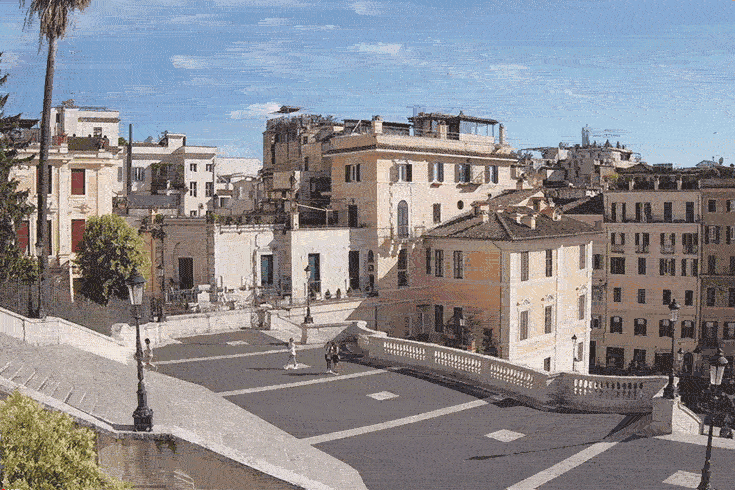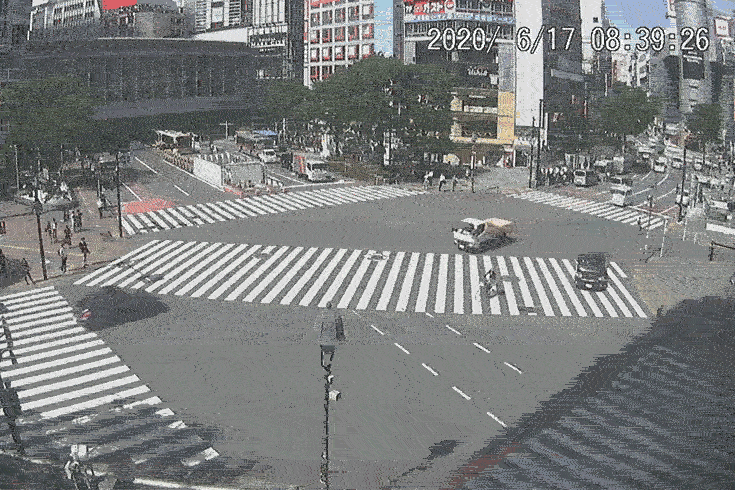My obsession with webcams took off during the third week of March. As a travel writer stuck at home, in self-isolation, with no possibility of an actual trip on the horizon, I found myself tuning in to live streams from public spaces around the world. First it was Tokyo’s Shibuya Crossing, that massive traffic intersection where people move in patterns under cute Japanese bubble umbrellas. I was surprised to discover the crowds only slightly sparser than they’d been on my recent visit. A few clicks later, I was off to rural Czech train stations, platforms bathed in strange yellow light, destination signs wobbling in the wind. I checked out the Castro in San Francisco, hoping to catch a glimpse of friends who live nearby, followed by a random stretch of New Zealand road, near Wellington Airport, so boring that my eleven-year-old son and I actually gasped when a truck drove by. But it’s to the webcams of Rome, specifically the feed from the Spanish Steps, that I return almost daily. A ticker at the bottom of my screen indicates that other armchair voyeurs are online here—between 200 and 2,000 of us at any given hour during quarantine. In this moment, when people can no longer just pick up and go, I’m not alone in finding other tickets to travel, discovering other ways of seeing.
The Spanish Steps webcam is affixed to the dental clinic of Dottore Mazzocco at 66 Piazza di Spagna. From this vantage point, the travertine-and-marble staircase rises majestically to the right. Built in the 1720s and recently refurbished by jeweller Bulgari to repair damage inflicted by so many tourist feet, the steps lead to the Trinità dei Monti church, hidden offscreen. A blurry sign on an adjacent building denotes a museum where the young English poet John Keats died of tuberculosis in 1821 (after being quarantined, incidentally, for typhus on his arrival in Italy). In the foreground is La Fontana della Barcaccia, a half-submerged boat spouting water, designed by the sculptor Pietro Bernini in the early 1600s.
In normal times, the piazza would be bustling with visitors, but now, without a thousand exposed legs in the frame, the architectural details stand out more. In the depths of lockdown, the few locals passing by can’t resist pausing to take photos of their neighbourhood landmark. From 4,000 miles away, I watch them crouch, with smartphones and cameras, sometimes setting up tripods, to get that perfect shot of the fountain in the foreground with the steps behind.
Enjoying Romans enjoying the sights of an emptied Rome puts a different focus on the relationship between traveller and destination. In the global tourism economy, with visitors from around the world rushing between historic sites, snapping sunburned selfies, and snarfing up food specialties, the very essence of a place can be eroded by the volume of people who arrive in search of authentic experiences. They bring money, sure, but also sweaty hands that degrade ancient ruins, demands for cheap lodging that turn neighbourhoods into Airbnb colonies, and the expectation to be catered to on their own terms. Case in point: the overcrowding of Venice, which is at risk of losing its UNESCO World Heritage designation due to damage and a lack of long-term city planning. Now, during COVID-19, being part of the travelling class comes with the added awareness that returning to the comforts of home may mean leaving behind a disease that local health care systems are not equipped to handle.
What the lens of the Piazza di Spagna webcam reveals, in its own intimate way, is that so-called bucket-list destinations are, and always have been, real places where real people live. With most of the world locked down, these public live streams offer a new perspective; with the tourists gone, places appear all the realer.
In the world of webcams, when not much happens, there’s more to notice. Under quarantine, the main players in the daily drama of the Piazza di Spagna are members of the Carabinieri and the Polizia di Stato who are stationed in the square. They zip onto the scene in compact cars, which they somehow manage to park in tandem, opening the doors simultaneously. Mostly, they stand around in uniform, asking for papers from some but curiously not all passersby. Otherwise, they’re busy talking with animated hand gestures, smoking, and occasionally taking their own panoramic shots of the steps. My eye makes assumptions even at this remove: from one policeman’s wide stance, rocking gently back and forth, I deduce that he has a young child—anyone who has tried to get a baby to sleep recognizes this rhythm of being at sea in the middle of the night.

What’s nice about this particular webcam is the sound: the water runs like rain in the fountain, seagulls squawk and honk. When it’s windy in Rome, it sounds like someone breathing into a microphone. The feed often picks up noises from unseen sources: the ringing of a doorbell; a passerby’s belch, wet with regret and red wine; and numerous sneezes, coughs, horks, and nose blowings. “Bello, bello,” a male voice somewhere beneath the dentist’s office is saying into the phone, talking warmly to someone he cares for—a woman, I think, possibly a sister or a mother or an aunt. Definitely not a lover. He finishes the conversation, and there are soft sounds, piano, staccato. I think he’s crying.
It’s easy to become addicted to this onscreen world as the light changes from day to night. Watching and waiting, I’m aware that Rome may never again look quite like it does during these moments, so empty, so unselfconscious, so indifferent to my gaze. I’m almost afraid I’ll miss something whenever I close my laptop. I take countless screen shots, as one might do with travel photos, to document my presence in this place. I catch an officer bending down to drink from the boat fountain; its water, fed from an ancient aqueduct dating back to 19 BC, is said by some to have restorative powers. I take one shot of a priest in a black cassock as he strides off Via dei Condotti into the square, lower left quadrant. Another memory: dogs straining at their leashes to greet each other as their owners (always with the nice shoes, those Italians) pass like ships.
I notice the way some people walk leading with their heads, the rest of the body playing catch-up, like dejected marionettes with iPhones outstretched. Others run through the square like furtive herbivores in leggings, all eyes and shoes. These cameos have potential for so many narratives.
After weeks of watching, I feel I’ve come to know parts of Rome quite well, although in reality I’ve only ever passed through the city in transit to other parts of Italy. Beyond the Piazza di Spagna, Rome’s network of webcams offers a selection of streets, squares, and heritage sites. Tight framing makes Trevi Fountain look like a glorified bathtub. Online, it’s best viewed after sunset for dramatic uplighting—100 LEDs recently added in a restoration sponsored by Fendi—that catches ripples of turquoise water and digitized details of baroque ornamentation, such as the swirl of Oceanus’ robe and the snouts of his sea horses. Named for the tre vie, or three roads, that lead to it, Trevi is another popular tourist stop: typically, some 3,000 euros worth of coins are thrown into it each day by wishful visitors (one coin for a return to Rome, two for the promise of romance). Sightings of civilians here during lockdown are, as my son would say about a video game character, super rare.
The Pantheon cam is busier—people come to get sandwiches from the salumeria across the way, standing far apart while munching pensively. At night, darkness is thick in this corner of the city, and the 2000-year-old columns of the ancient Roman temple could be computer-generated renderings.
As with any real-life tour, sometimes the big draws aren’t necessarily the scenes that stick with you. I’ll tell you now that the feed of the Colosseum holds little interest—neither of its two cameras are particularly well placed. Likewise, the standard view of stately Piazza Navona, with its monumental baroque architecture, is as flat as a postcard. The cam pointed in the other direction, however, is a whole different scenario: after dark, a tall and shadowy Bernini fountain bubbles in the foreground, and the colours are all muddy oil pastels and subdued beiges, greys, and blues in a wash of lantern light. The lines of the buildings seem drawn by a slightly wobbly hand, as if the artist were losing their eyesight. As an off-the-beaten-path traveller myself, I prefer the less grandiose, like the webcam that frames a short, dead section of Via del Corso, where lighting from empty shop windows spreads wetly on rainy sidewalks. It is absolute film noir, provided you’re okay with a suspense movie where nothing ever happens.

Campo de’ Fiori, the wide rectangular market area usually full of vendors, is often so still that the feed appears frozen until a bird flies by or a lone interloper with a dog wanders through. (Seeing that same dog walker on two different occasions is akin to recognizing a distant relative.) Still, there’s much to muse on: the statue of the former Dominican cleric Giordano Bruno, for example. An early cosmologist, theologian, memory artist, and philosopher, it was Bruno’s conviction that the universe was infinite. He was burned at the stake, in this spot, in 1600, gagged so that he could not make one last speech. Bruno believed that not just humans but the Earth and the universe possessed souls. Looking at Rome through a lens from halfway around the world, there’s little doubt that cities have souls too.
When the official announcement of Italy’s loosened restrictions came, at the end of April, I’d already felt the Piazza di Spagna coming back to life: church bells were chiming more insistently, passersby lingered a little longer. When I open my laptop, it’s surprising to hear, over the familiar soundtrack of the fountain, warm voices greeting each other, children skipping and calling out, the warning whistle of a police officer. People appear to be pausing to look with new eyes, marvelling at what’s still here now that the pandemic has waned. It’s a relief that the vice grip has loosened, yet I’m wistful for the time when there was a little less happening. Having watched over the city while it slept, I feel an urge to improve my Italian—when I visit in real life, I’d like to be able to tell local Romans that I bore witness during those dark times.
Even now, with European borders reopening for much-needed tourism, I’m hooked on the webcam world. At my bedtime—the deep predawn hours of Central European Time—the Spanish Steps are as quiet as ever. The Carabinieri’s cars have gone, the pixelated palm fronds tell of a gentle breeze, cobblestones glimmer like fish scales in the grey night, the travertine steps are as pale as the moon. My eye is drawn to a hint of movement at the left edge of the feed. A tiny form, with a strange side-to-side shuffle, is coming into my field of vision. My first thought is penguin, but it is too big to be a penguin, and of course it can’t be a penguin. I zoom in to find that it’s a little old lady in a black dress. She has come out of her house under cover of night, just to the edge of my screen and no farther, to look at the fountain. I hold my breath as we both listen to the water flowing. Then she turns, and with a slow, strange gait, like a windup toy that’s winding down, she disappears to the world beyond the camera. I feel as though I have been waiting for her all these weeks, both of us living in this time, somewhere between seen and unseen.






